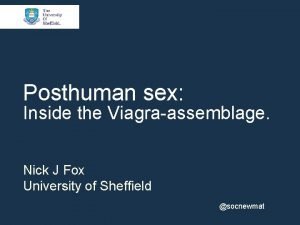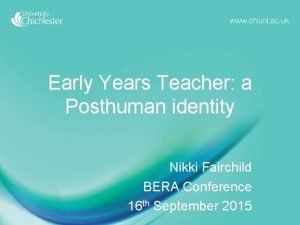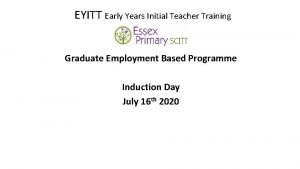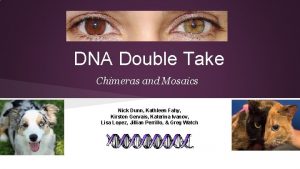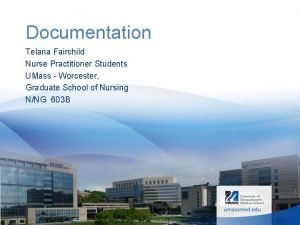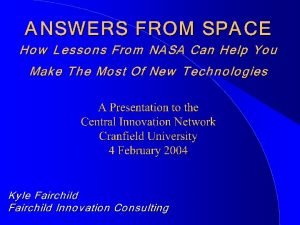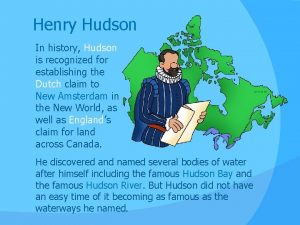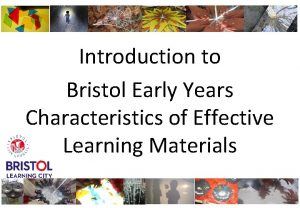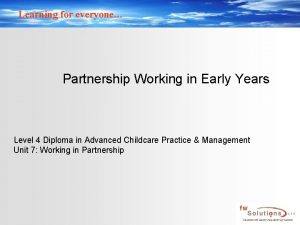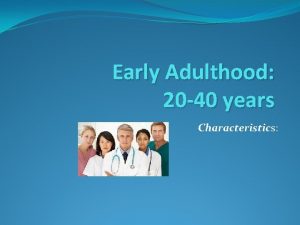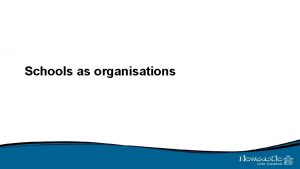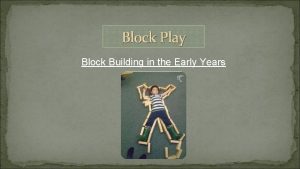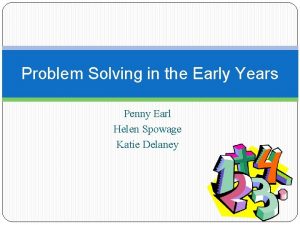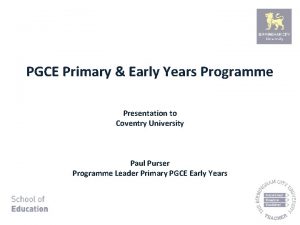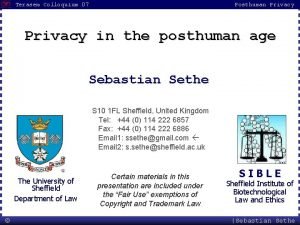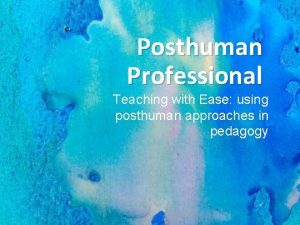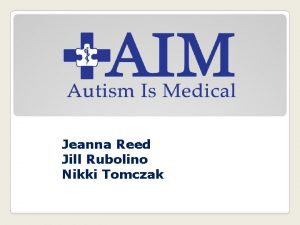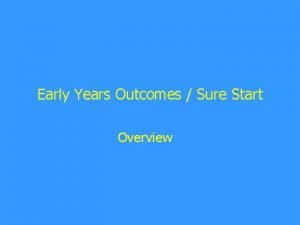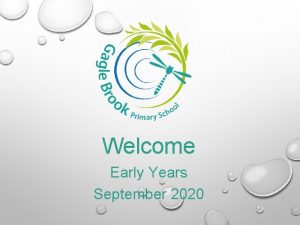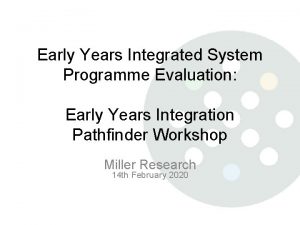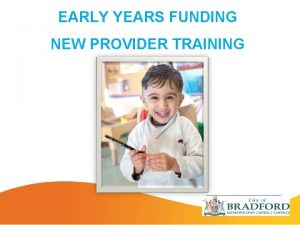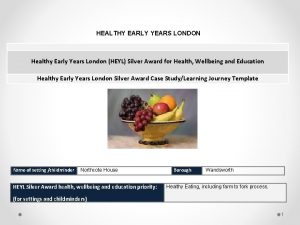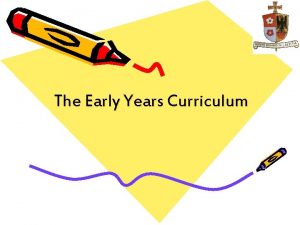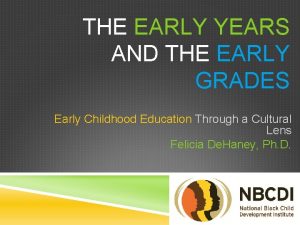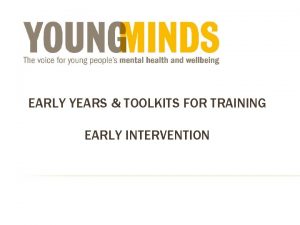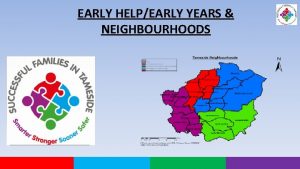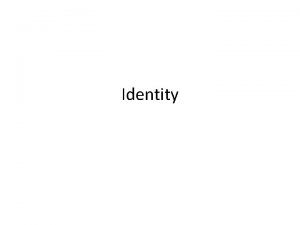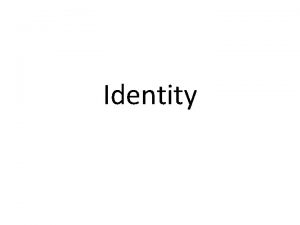Early Years Teacher a Posthuman identity Nikki Fairchild


















- Slides: 18

Early Years Teacher: a Posthuman identity Nikki Fairchild BERA Conference 16 th September 2015

Aims of this presentation • To chart progress of my doctoral studies; • To consider how Posthumanist theorising can build on concepts of professional identity; • This paper reflect on ways to use Posthumanist theorising with data separate to my doctoral studies; • To details my next steps. 19 February 2021 Uo. C – Nikki Fairchild 2

Researcher becomings • End of second year of my doctoral studies; • Close reading of Posthumanist theory, particularly work of Deleuze and Guattari (1984; 1987); • Reflecting on Mac. Lure (2010: pp. 277) who argues theory should ‘offend and interrupt’ and offer possibilities for opening up new thinking; • Considering how to put Posthumanist theory to work within my research. 19 February 2021 Nikki Fairchild 3

Why Posthumanist theorising? Different philosophical position to explore the decentred subject (Wolfe, 2010). • (Re)framing of binary opposites (Jones and Holmes 2014); • Social world as mobile, messy, creative, changing and open ended, sensory and affective (Coleman and Ringrose 2013); • Mindful of the instability of the divide between theory and practice (Coleman and Ringrose 2013). 19 February 2021 Nikki Fairchild 4

Key terminology (1) Assemblage Objects, utterances, institutions, bodies and fragments interrelate…. . as a mix rather than a hierarchy. These entanglements form a ‘cabinet of curiosities’ (Mac. Lure, 2013: 165).

Key terminology (2) Becoming • Subjectivities are multiplicities. Subject characterised by flows of forces, intensities, desires and are continually formed and reformed by ‘dynamic individuation’ from which the changing self emerges. (Deleuze and Parnet, 1987: 93, citied in Taylor, 2013). • The process is a metamorphosis - no end product – constantly changing (Braidotti, 2002). Nikki Fairchild - University of Chichester

Key terminology (3) Molar – Regimes of power – fixed and fitted into preexisting categories (macro); Molecular – The little cracks, micro-politics of becoming, the ruptures (micro); Lines of flight – Changes in direction the molar and molecular interactions. Nikki Fairchild - University of Chichester

A Posthuman identity…. • Identity - society makes sense of a changing world (Deleuze and Guattari, 1987); • When bodies are stratified a stable sense of self produces of ‘the thinking, speaking political subject’ (Hickey-Moody and Malins, 2007, p. 5); • Difference is positive and productive - new ways of becoming (Deleuze, 1994); • Subject - continual becoming enmeshed and connected with other bodies, nature and machines (Gibson, 2006). 19 February 2021 Nikki Fairchild 8

How do I intend to use Posthumanism? I propose to chart professional becomings as a way to move forward current conceptualisations of professional identity: • • • Relational assemblage reflect the material working of power and move beyond social construction to social production (Coole and Frost, 2010 pp. 7). Ontological positioning - move beyond ‘the mind-matter and culture-nature divides of transcendental humanist thought’ (Van der Tuin and Dolphijn, 2010, pp. 155) to a position of ‘and……and…. and’ rather than binary dualisms of self and other. Agency is greater than human actions (Fox and Alldred, 2015) and that the affective nature of relational networks and human and more than human assemblages become important (De. Landa, 2006). 19 February 2021 Nikki Fairchild 9

Early Years Teacher placement events • Semi-structured interview data collected from a small scale research project funded by the HEA; • All participants (n=13) had taken part in Early Years Teacher/Professional Status training (having limited early years experience); • Data analysed using a rhizomatic analysis to chart lines of flight and minutiae of professional practice (Honan and Sellars, 2006). 19 February 2021 Nikki Fairchild 10

Event 1 - Laura “For me it was I had to get very organised have the activity Student Assemblage really well planned and when I go to the teacher and need to University~books/reading~placement~ be able to explain this within a minute. ‘Look I have professional standards~other witnessed this activity between the children and they seem students~children~placement to like itstaff~assessment~expectations so I want to do it’. It has to be really clear, concise and precise. ‘Can I have five. Professional minutes. Nursery of your group time or can I Assemblage set this up in free play’? becoming The first setting I had and to stay quiet Children~staff~policies for three months and try not toproceedures~Early do too much. Years They were Foundation being a little more sensitive about being told what to do by Stage~practice~parents~ the student. When I did the activity I needed to make sure it was environment and done well and tidy so staff did not feel like I had given then more resources~students jobs. ” (Full pathway Early Years Professional candidate) 19 February 2021 Nikki Fairchild 11

Event 2 - Ava “There was one particular child…. . he was virtually mute in the School assemblage Placement~staff~parents~ nursery but was very chatty at home so I picked up on his and interests. children~ethos Combined that with the least messy sensory play I philsophy~phonics~EYFS~ could find and he really responded well and I could move up curricula expectations and up to messier play and she watched him come out of Professional himself and he was really chatty and he joined me with the Becoming phonics and the sounds, she could not get him to sound out his Student Assemblage e sounds, so I did in the hallandlike we did nsbig musical games Childs needs o esp r statutes and then added to sound out a snake ‘SSSSSS’ and interests~curricula e v i expectation~environment~video~ ect spiders and that kind of thing and he would giggle and be a part f f A parents~Staff~assessment~ of it…so she videoed that (my activities) and showed it to the professional standards parents…. ” (Full Pathway Early Years Professional candidate) 19 February 2021 Nikki Fairchild 12

Event 3 - Isabelle Af res fecti ve childpodevelopment ns e “I received a lot of information about which I find useful day to day. There were different themes looking at management style and multi-agency working. Most of this was new information and was beneficial, getting the Student Assemblage references allowed me to look in the library or go onto Amazon. University~knowledge~library~ Having the initial topic then allowed me to investigate Professional books~Amazon~experienced further…. I think in the mixed session where they [more becoming students~information experienced students] had been in business for years and things where we would go ‘is that normal’ they would all look at us and go ‘yes’! After 15 years in the field they might have looked at us and thought we were silly. ” (GEP Early Years Teacher Trainee) 19 February 2021 Nikki Fairchild 13

What does this show us? • Entering the assemblage allows professional becomings to be viewed as a process of (re)making a thing; • The events in this paper detail machinic assemblages in action; • All three participants experienced their own becomings as nomads (Braidotti, 2011); • Professional becomings can explore and (re)configure complexity within the everyday lives of practitioners. 19 February 2021 Nikki Fairchild 14

Next Steps • Continue with close reading and grappling with dense and challenging theory; • Finalise methodology chapter • Thesis upgrade at the end of December 2015; • Data collection 2015; • Continue to consider data analysis…… 19 February 2021 Nikki Fairchild 15

Bibliography (1) • • • Braidotti, R. (2002) Metamorphosis: Towards and Materialist Theory of Becoming. Cambridge: Polity. Braidotti, R. (2011) Nomadic Theory. The Portable Rosi Braidotti. New York: Columbia University Press. Coleman, R. & Ringrose, J. (Ed. ) (2013) Deleuze and Research Methodology. Edinburgh: Edinburgh University Press. Coole, D. H. and Frost, S. (2010) (Eds. ) New Materialisms: Ontology, agency, and politics. Durham, NC: Duke University Press. De. Landa, M. (2006) A New philosophy of society. London: Continuum. Deleuze, G. (1994) Difference and repetition. London: Athalone Press. Deleuze, G. and Guattari, F. (1984) What is philosophy? Trans. By G. Burchell and H. Tomlinson. London: Verso. Deleuze, G. and Guattari, F. (1987) A Thousand Plateaus: Capitalism and Schizophrenia. London: Bloomsbury Academic. Fox, N. J. and Alldred, P. (2015) New materialist social inquiry: designs, methods and the research-assemblage, International Journal of Social Research Methodology, 18 (4), 399 -414. Gibson, B. E. (2006) Disability, Connectivity and Transgressing the Autonomous Body, Journal of Medical Humanities, 27, 531 -546. 19 February 2021 Uo. C - Nikki Fairchild 16

Bibliography (2) • • Hickey-Moody, A. and Malins, P. (2007) Introduction: Gilles Deleuze and Four Movements in Social Thought, in A. Hickey-Moody and P. Malins (Eds. ) Deleuzian Encounters. Studies in Contemporary Social Issues. Basingstoke: Palgrave Mac. Millan. Honan, E. and Sellars, M. (2006) So how does it work? – rhizomatic methodologies. Engaging Pedagogies: Australian Association for Research in Education International Conference, Adelaide, SA: AARE. Jones, L. & Holmes, R. (2014) ‘Studying play through new research practices’ in L. Brooker, M. Blaise & S. Edwards (Ed) The Sage Handbook of Play and Learning in Early Childhood. London: Sage. Mac. Lure, M. (2010) ‘The Offence of Theory’. Journal of Education Policy. 25(2), pp. 277 -286. Mac. Lure, R. (2013) ‘Classification or Wonder? Coding as an Analytical Practice in Qualitative Research’, in Coleman, R. & Ringrose, J. (Ed. ) Deleuze and Research Methodology. Edinburgh: Edinburgh University Press. Taylor, C. A. (2013) ‘Mobile Sections and Flowering Matter in Participant-Generated Video: Exploring a Deleuzian Approach to Visual Sociology’ , in Coleman, R. & Ringrose, J. (Ed. ) Deleuze and Research Methodology. Edinburgh: Edinburgh University Press. Van der Tuin, I. and Dolphijn, R. (2010) ‘The transversality of new materialism’, Women: A Cultural Review, 21, 153 -171. Wolfe, C. (2010) What is Posthumanism. Minneapolis: University of Minnesota Press. 19 February 2021 Uo. C - Nikki Fairchild 17

Contact Details Title, Nikki Fairchild Senior Lecturer Department of Childhood, Social Work and Social Care, University of Chichester, College Lane, Chichester, West Sussex, PO 19 6 PE. Tel: 01243 816287 Email: n. fairchild@chi. ac. uk 19 February 2021 BERA – Nikki Fairchild 18
 Nick fox sex
Nick fox sex Nikki fairchild videos
Nikki fairchild videos Early years teacher standards
Early years teacher standards Lydia fairchild
Lydia fairchild Soapier documentation
Soapier documentation Kyle fairchild
Kyle fairchild 300 solar years to lunar years
300 solar years to lunar years How many years is four score and seven years
How many years is four score and seven years Sheep years to human years
Sheep years to human years Henry hudson netherlands
Henry hudson netherlands Bristol characteristics of effective learning
Bristol characteristics of effective learning Partnership working in early years
Partnership working in early years Characteristics of early adulthood
Characteristics of early adulthood Summarise types of early years provision
Summarise types of early years provision Block play early years
Block play early years Eyfs moodle hampshire
Eyfs moodle hampshire Penny earl and mark
Penny earl and mark Dsl network nottingham
Dsl network nottingham Pgce early years
Pgce early years
